
Home - Search - Browse - Alphabetic Index: 0- 1- 2- 3- 4- 5- 6- 7- 8- 9
A- B- C- D- E- F- G- H- I- J- K- L- M- N- O- P- Q- R- S- T- U- V- W- X- Y- Z
Apollo 16
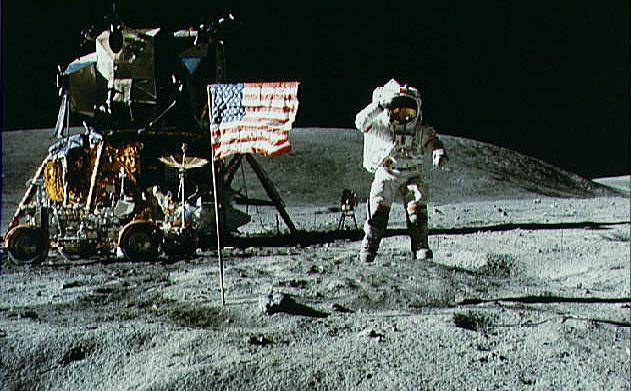
Apollo 16 1/6 G leap
Apollo astronaut demonstrates low lunar gravity.
Credit: NASA
AKA: Caspar. Launched: 1972-04-16. Returned: 1972-04-27. Number crew: 3 . Duration: 11.08 days. Location: Alabama Space and Rocket Center, Huntsville, AL.
The Apollo 16 (AS-511) space vehicle was launched from Pad A, Launch Complex 39, KSC, at 12:54 p.m. EST April 16, with a crew of astronauts John W. Young, Thomas K. Mattingly II, and Charles M. Duke, Jr. After insertion into an earth parking orbit for spacecraft system checks, the spacecraft and the S-IVB stage were placed on a trajectory to the moon at 3:28 p.m. CSM transposition and docking with the LM were achieved, although a number of minor anomalies were noted.
One anomaly, an auxiliary propulsion system leak on the S-IVB stage, produced an unpredictable thrust and prevented a final S-IVB targeting maneuver after separation from the CSM. Tracking of the S-IVB ended at 4:04 p.m. EST April 17, when the instrument unit's signal was lost. The stage hit the lunar surface at 4:02 p.m. April 19, 260 kilometers northeast of the target point. The impact was detected by the seismometers left on the moon by the Apollo 12, 14, and 15 missions.
Spacecraft operations were near normal during the coast to the moon. Unexplained light-colored particles from the LM were investigated and identified as shredded thermal paint. Other activities during the translunar coast included a cislunar navigation exercise, ultraviolet photography of the earth and moon, an electrophoresis demonstration, and an investigation of the visual light-flash phenomenon noted on previous flights. Astronaut Duke counted 70 white, instantaneous light flashes that left no after-glow.
Apollo 16 entered a lunar orbit of 314 by 107.7 kilometers at 3:22 p.m. April 19. After separation of LM-11 Orion from CSM 112 Casper, a CSM active rendezvous kept the two vehicles close together while an anomaly discovered on the service propulsion system was evaluated. Tests and analyses showed the redundant system to be still safe and usable if required. The vehicles were again separated and the mission continued on a revised timeline because of the 5 3/4-hour delay.
The lunar module landed with Duke and Young in the moon's Descartes region, about 230 meters northwest of the planned target area at 9:23 p.m. EST April 20. A sleep period was scheduled before EVA.
The first extravehicular activity began at 11:59 a.m. April 21, after the eight-hour rest period. Television coverage of surface activity was delayed until the lunar roving vehicle systems were activated, because the steerable antenna on the lunar module could not be used. The lunar surface experiments packages were deployed, but accidental breaking of the electronics cable rendered the heat flow experiment inoperable. After completing activities at the experiments site, the crew drove the lunar roving vehicle west to Flag Crater, where they performed the planned tasks. The inbound traverse route was just slightly south of the outbound route, and the next stop was Spook Crater. The crew then returned via the experiment station to the lunar module and deployed the solar wind composition experiment. The duration of the extravehicular activity was 7 hours 11 minutes. The distance traveled by the lunar roving vehicle was 4.2 kilometers. The crew collected 20 kilograms of samples.
The second extravehicular traverse, which began at 11:33 a.m. April 22, was south-southeast to a mare-sampling area near the Cinco Craters on Stone Mountain. The crew then drove in a northwesterly direction, making stops near Stubby and Wreck Craters. The last leg of the traverse was north to the experiments station and the lunar module. The second extravehicular activity lasted 7 hours 23 minutes. The distance traveled by the lunar roving vehicle was 11.1 kilometers.
Four stations were deleted from the third extravehicular traverse, which began 30 minutes early at 10:27 a.m. April 23 to allow extra time. The first stop was North Ray Crater, where "House Rock" on the rim of the crater was sampled. The crew then drove southeast to "Shadow Rock." The return route to the LM retraced the outbound route. The third extravehicular activity lasted 5 hours 40 minutes, and the lunar roving vehicle traveled 11.4 kilometers.
Lunar surface activities outside the LM totaled 20 hours 15 minutes for the mission. The total distance traveled in the lunar roving vehicle was 26.7 kilometers. The crew remained on the lunar surface 71 hours 02 minutes and collected 96.6 kilograms of lunar samples.
While the lunar module crew was on the surface, Mattingly, orbiting the moon in the CSM, was obtaining photographs, measuring physical properties of the moon and deep space, and making visual observations. Essentially the same complement of instruments was used to gather data as was used on the Apollo 15 mission, but different areas of the lunar surface were flown over and more comprehensive deep space measurements were made, providing scientific data that could be used to validate findings from Apollo 15 as well as add to the total store of knowledge of the moon and its atmosphere, the solar system, and galactic space.
The LM lifted off from the moon at 8:26 p.m. EST April 23, rendezvoused with the CSM, and docked with it in orbit. Young and Duke transferred to the CSM with samples, film, and equipment, and the LM was jettisoned the next day. LM attitude control was lost at jettison; therefore a deorbit maneuver was not possible and the LM remained in lunar orbit, with an estimated orbital lifetime of about one year.
The particles and fields subsatellite was launched into lunar orbit and normal system operation was noted. However, the spacecraft orbital shaping maneuver was not performed before ejection and the subsatellite was placed in a non-optimum orbit that resulted in a much shorter lifetime than the planned year. Loss of all subsatellite tracking and telemetry data on the 425th revolution (May 29) indicated that the subsatellite had hit the lunar surface.
The mass spectrometer deployment boom stalled during a retract cycle and was jettisoned before transearth injection. The second plane-change maneuver and some orbital science photography were deleted so that transearth injection could be performed about 24 hours earlier than originally planned.
Activities during the transearth coast phase of the mission included photography for a contamination study for the Skylab program and completion of the visual light-flash-phenomenon investigation that had been partially accomplished during translunar coast. A 1-hour 24-minute transearth extravehicular activity was conducted by command module pilot Mattingly to retrieve the film cassettes from the scientific instrument module cameras, inspect the equipment, and expose a microbial-response experiment to the space environment. Two midcourse corrections were made on the return flight to achieve the desired entry interface conditions.
Entry and landing were normal, completing a 265-hour 51-minute mission. The command module was viewed on television while dropping on the drogue parachutes, and continuous coverage was provided through crew recovery. Splashdown was at 2:44 p.m. EST April 27 in mid-Pacific, 5 kilometers from the recovery ship U.S.S. Ticonderoga. All primary mission objectives had been achieved.
Official NASA Account of the Mission from Where No Man Has Gone Before: A History of Apollo Lunar Exploration Missions, by W. David Compton, published as NASA SP-4214 in the NASA History Series, 1989.
Apollo 16 blasted off from Kennedy Space Center at 12:54 p.m. Eastern Standard Time on April 16, 1972. Command module Casper and lunar module Orion arrived in lunar orbit three days later. All systems functioned well until Orion separated from the command module; a malfunctioning component in the main propulsion system caused Houston to delay the lunar module's descent for nearly six hours while it was checked out. When Mission Control was satisfied, Orion fired its descent engine and landed easily on the plain at Descartes at 9:33 p.m. EST on April 20.
In the next 71 hours mission commander John Young and lunar module pilot Charles Duke laid out the surface instruments and conducted three traverses in their lunar rover, covering in all some 27 kilometers (nearly 17 miles). While they were busy on the surface, Ken Mattingly in Casper was occupied with operating the instruments in the service module. The only serious mishap on the surface occurred when Young tripped over the cable to the heat-flow sensors, pulling it loose from the central station and incapacitating the experiment.
Young and Duke finished their exploration, loaded the 96 kilograms (210 pounds) of samples they had collected into Orion , and rejoined Mattingly in lunar orbit on April 23. They released the moon-orbiting subsatellite, but because of recurring problems with the service propulsion system, the spacecraft was not in the optimum orbit for the satellite. As a result, the satellite crashed into the moon after only five weeks. During the four-day return flight they conducted additional experiments with electrophoresis, a technique that offered advantages for separating certain biological preparations that could not be efficiently done in a gravity field. A normal landing in the Pacific, north of Christmas Island, completed the mission On April 27.
More at: Apollo 16.
Family: Manned spaceflight. People: Duke, Mattingly, Young. Country: USA. Spacecraft: Apollo CSM. Projects: Apollo. Launch Sites: Cape Canaveral. Agency: NASA Houston.
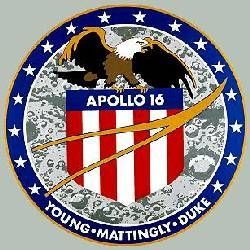 | Apollo 16 Credit: www.spacefacts.de |
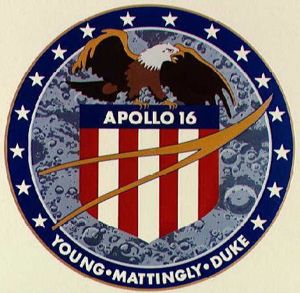 | Apollo 16 Apollo 16 Patch Credit: NASA |
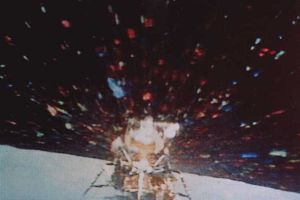 | Apollo 16 LM Liftoff Credit: NASA |
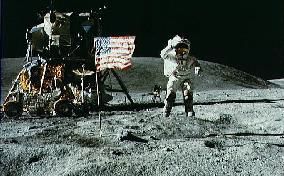 | Apollo 16 crewman Apollo 16 crewman demonstrated 1/6 G Credit: NASA |
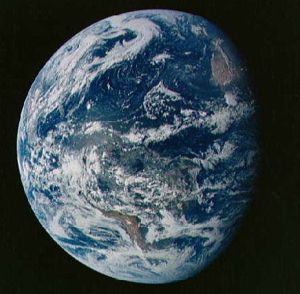 | Apollo 16 The earth from space Credit: NASA |
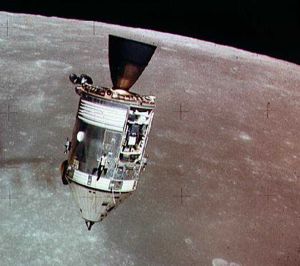 | Apollo 16 CSM in lunar orbit Credit: NASA |
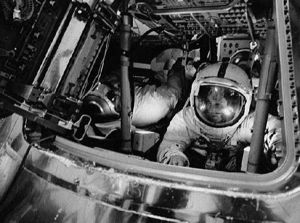 | Apollo 16 In the trainer Credit: NASA |
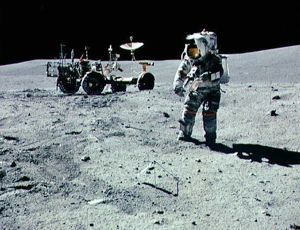 | Apollo 16 Lunar rover on the surface Credit: NASA |
 | Apollo 16 Deep space EVA Credit: NASA |
1968 November 27 - .
- Apollo LM-11 midsection assembly collapsed - .
Nation: USA.
Program: Apollo.
Flight: Apollo 16.
Spacecraft: Apollo LM,
LM Structural.
The LM-11 midsection assembly collapsed in the assembly jig during the bulkhead prefitting stage of construction at Grumman. The structure buckled when the bulkheads, which had just been prefitted and drilled, were removed to permit deburring the drilled holes. Jig gates that were supposed to hold up the assembly were not in position, nor was the safety line properly installed. The structure was supported by hand. Damage to the skin of the structure was not severe, although a small radius bend was put in one of the upper skins.
1969 July 29 - .
- Tentative planning schedule for the Apollo program - .
Nation: USA.
Program: Apollo.
Flight: Apollo 12,
Apollo 13,
Apollo 14,
Apollo 15,
Apollo 16,
Apollo 17,
Apollo 18,
Apollo 19,
Apollo 20.
Spacecraft: Apollo Lunar Landing,
Surveyor.
NASA issued a tentative planning schedule for the Apollo program:
Flight Launch Plans Tentative Landing Area Apollo 12 November 1969 Oceanus Procellarum lunar lowlands Apollo 13 March 1970 Fra Mauro highlands Apollo 14 July 1970 Crater Censorinus highlands Apollo 15 November 1970 Littrow volcanic area Apollo 16 April 1971 Crater Tycho (Surveyor VII impact area) Apollo 17 September 1971 Marius Hills volcanic domes Apollo 18 February 1972 Schroter's Valley, riverlike channel-ways Apollo 19 July 1972 Hyginus Rille region-Linear Rille, crater area Apollo 20 December 1972 Crater Copernicus, large crater impact area
1969 October 10 - .
- Major milestones for the Apollo 16-20 missions - .
Nation: USA.
Program: Apollo.
Flight: Apollo 16.
Spacecraft: A7L.
Major milestones were reached for extending astronauts' staytime on the moon and increasing their mobility for the Apollo 16-20 missions. Modifications in the A7L spacesuit incorporating improved waist mobility were authorized, and letter contract authority for the portable life support system secondary life support system was approved.
1969 October 22 - .
- Opposition to a major effort to develop a lunar flyer until after the Apollo 16 mission - .
Nation: USA.
Program: Apollo.
Flight: Apollo 11,
Apollo 16.
Spacecraft: LFV North American.
The Flight Crew Operations Directorate expressed opposition to a major effort to develop a lunar flyer until after the Apollo 16 mission. Plans for Apollo flights 12 through 16 required that the LM be maneuvered to landings at various points of scientific interest on the lunar surface, and experience from Apollo 11 and partial gravity simulators indicated the crews would be able to accomplish their surface EVA tasks for these missions without the aid of a mobility device.
1970 January 16 - .
- Apollo 16-19 lunar orbital science experiments revised - .
Nation: USA.
Program: Apollo.
Flight: Apollo 16.
An MSC meeting to realign the Apollo 16-19 lunar orbital science experiments recommended that the Sounding Radar Experiment, S-167, be deleted and the Lunar Electromagnetic Sounder, S-168, should be developed and flown. Scientific-value for the experiments was ranked in the following descending priorities for the various scientific disciplines: geochemistry, particles and fields, imagery and geodesy, surface and subsurface profiles, and atmospheres.
1970 January 29 - .
- Ground rules for Apollo service module design and integration established - .
Nation: USA.
Program: Apollo.
Flight: Apollo 15,
Apollo 16,
Apollo 18,
Apollo 19.
Spacecraft: Apollo CSM,
CSM Block II.
Ground rules for service module design and integration, established during recent changes in the lunar orbital science program, were reported. The Apollo LM experiment hardware would be installed and tested at KSC. A single scientific instrument module configuration was being proposed for Apollo 16-19 with modification kits developed, as required, to install Apollo 18 and Apollo 19 experiments. An expanded Apollo LM data system would be available for Apollo 16 (spacecraft 112).
1971 May 5 - .
- Apollo Site Selection Board selected Descartes as the Apollo 16 site - .
Nation: USA.
Program: Apollo.
Flight: Apollo 16.
The Apollo Site Selection Board selected Descartes as the Apollo 16 site. However, after the selection, a discussion began as to whether the Kant or Descartes region would be the better choice. NASA finally decided to go with the original selection of the Board: Descartes would be the prime Apollo 16 Site.
1971 May 13 - .
- Contamination measurements on the remaining Apollo flights for use in Skylab planning - .
Nation: USA.
Program: Apollo.
Flight: Apollo 15,
Apollo 16.
NASA was considering a plan for obtaining contamination measurements on the remaining Apollo flights for use in Skylab planning. The plan required photography on Apollo 15 of liquid dumps, limited magnitude starfield, and window deposition photography. Apollo 16 and 17 would carry instrumentation to measure cloud intensity and effects, deposits and their effects, critical surfaces, particle count, surface charge potential, and pressure.
1971 October 6-7 - .
- Apollo 15 anomalies - . Nation: USA. Program: Apollo. Flight: Apollo 15, Apollo 16. Spacecraft: Apollo CSM, LM Electrical, LM RCS. Major items of discussion during the Manned Space Flight Management Council meeting in Washington were the Apollo 15 anomalies. . Additional Details: here....
1972 March 8 - .
- Olympic Games flag to be carried in the command module during the Apollo 16 mission - . Nation: USA. Program: Apollo. Flight: Apollo 16. Spacecraft: Apollo CSM, LM Weight. An Olympic Games flag 1.2 by 1.8 meters would be packed in a fireproof container and carried in the command module during the Apollo 16 mission. . Additional Details: here....
1972 April 16 - . 17:54 GMT - . Launch Site: Cape Canaveral. Launch Complex: Cape Canaveral LC39A. Launch Platform: LUT3. Launch Vehicle: Saturn V.
- Apollo 16 - .
Call Sign: Caspar. Crew: Duke,
Mattingly,
Young.
Backup Crew: Haise,
Mitchell,
Roosa.
Payload: Apollo CSM 113/LM 11/ ALSEP/ LRV-2/PFS 2/S-IVB-511. Mass: 30,358 kg (66,927 lb). Nation: USA.
Agency: NASA Houston.
Program: Apollo.
Class: Moon.
Type: Manned lunar spacecraft. Flight: Apollo 16.
Spacecraft: Apollo CSM.
Duration: 11.08 days. Decay Date: 1972-04-27 . USAF Sat Cat: 6000 . COSPAR: 1972-031A. Apogee: 169 km (105 mi). Perigee: 167 km (103 mi). Inclination: 32.54 deg. Period: 88.93 min.
The Apollo 16 (AS-511) space vehicle was launched from Pad A, Launch Complex 39, KSC, at 12:54 p.m. EST April 16, with a crew of astronauts John W. Young, Thomas K. Mattingly II, and Charles M. Duke, Jr. After insertion into an earth parking orbit for spacecraft system checks, the spacecraft and the S-IVB stage were placed on a trajectory to the moon at 3:28 p.m. CSM transposition and docking with the LM were achieved, although a number of minor anomalies were noted.
One anomaly, an auxiliary propulsion system leak on the S-IVB stage, produced an unpredictable thrust and prevented a final S-IVB targeting maneuver after separation from the CSM. Tracking of the S-IVB ended at 4:04 p.m. EST April 17, when the instrument unit's signal was lost. The stage hit the lunar surface at 4:02 p.m. April 19, 260 kilometers northeast of the target point. The impact was detected by the seismometers left on the moon by the Apollo 12, 14, and 15 missions.
Spacecraft operations were near normal during the coast to the moon. Unexplained light-colored particles from the LM were investigated and identified as shredded thermal paint. Other activities during the translunar coast included a cislunar navigation exercise, ultraviolet photography of the earth and moon, an electrophoresis demonstration, and an investigation of the visual light-flash phenomenon noted on previous flights. Astronaut Duke counted 70 white, instantaneous light flashes that left no after-glow.
Apollo 16 entered a lunar orbit of 314 by 107.7 kilometers at 3:22 p.m. April 19. After separation of LM-11 Orion from CSM 112 Casper, a CSM active rendezvous kept the two vehicles close together while an anomaly discovered on the service propulsion system was evaluated. Tests and analyses showed the redundant system to be still safe and usable if required. The vehicles were again separated and the mission continued on a revised timeline because of the 5 3/4-hour delay.
The lunar module landed with Duke and Young in the moon's Descartes region, about 230 meters northwest of the planned target area at 9:23 p.m. EST April 20. A sleep period was scheduled before EVA.
The first extravehicular activity began at 11:59 a.m. April 21, after the eight-hour rest period. Television coverage of surface activity was delayed until the lunar roving vehicle systems were activated, because the steerable antenna on the lunar module could not be used. The lunar surface experiments packages were deployed, but accidental breaking of the electronics cable rendered the heat flow experiment inoperable. After completing activities at the experiments site, the crew drove the lunar roving vehicle west to Flag Crater, where they performed the planned tasks. The inbound traverse route was just slightly south of the outbound route, and the next stop was Spook Crater. The crew then returned via the experiment station to the lunar module and deployed the solar wind composition experiment. The duration of the extravehicular activity was 7 hours 11 minutes. The distance traveled by the lunar roving vehicle was 4.2 kilometers. The crew collected 20 kilograms of samples.
The second extravehicular traverse, which began at 11:33 a.m. April 22, was south-southeast to a mare-sampling area near the Cinco Craters on Stone Mountain. The crew then drove in a northwesterly direction, making stops near Stubby and Wreck Craters. The last leg of the traverse was north to the experiments station and the lunar module. The second extravehicular activity lasted 7 hours 23 minutes. The distance traveled by the lunar roving vehicle was 11.1 kilometers.
Four stations were deleted from the third extravehicular traverse, which began 30 minutes early at 10:27 a.m. April 23 to allow extra time. The first stop was North Ray Crater, where "House Rock" on the rim of the crater was sampled. The crew then drove southeast to "Shadow Rock." The return route to the LM retraced the outbound route. The third extravehicular activity lasted 5 hours 40 minutes, and the lunar roving vehicle traveled 11.4 kilometers.
Lunar surface activities outside the LM totaled 20 hours 15 minutes for the mission. The total distance traveled in the lunar roving vehicle was 26.7 kilometers. The crew remained on the lunar surface 71 hours 14 minutes and collected 96.6 kilograms of lunar samples.
While the lunar module crew was on the surface, Mattingly, orbiting the moon in the CSM, was obtaining photographs, measuring physical properties of the moon and deep space, and making visual observations. Essentially the same complement of instruments was used to gather data as was used on the Apollo 15 mission, but different areas of the lunar surface were flown over and more comprehensive deep space measurements were made, providing scientific data that could be used to validate findings from Apollo 15 as well as add to the total store of knowledge of the moon and its atmosphere, the solar system, and galactic space.
The LM lifted off from the moon at 8:26 p.m. EST April 23, rendezvoused with the CSM, and docked with it in orbit. Young and Duke transferred to the CSM with samples, film, and equipment, and the LM was jettisoned the next day. LM attitude control was lost at jettison; therefore a deorbit maneuver was not possible and the LM remained in lunar orbit, with an estimated orbital lifetime of about one year.
The particles and fields subsatellite was launched into lunar orbit and normal system operation was noted. However, the spacecraft orbital shaping maneuver was not performed before ejection and the subsatellite was placed in a non-optimum orbit that resulted in a much shorter lifetime than the planned year. Loss of all subsatellite tracking and telemetry data on the 425th revolution (May 29) indicated that the subsatellite had hit the lunar surface.
The mass spectrometer deployment boom stalled during a retract cycle and was jettisoned before transearth injection. The second plane-change maneuver and some orbital science photography were deleted so that transearth injection could be performed about 24 hours earlier than originally planned.
Activities during the transearth coast phase of the mission included photography for a contamination study for the Skylab program and completion of the visual light-flash-phenomenon investigation that had been partially accomplished during translunar coast. A 1-hour 24-minute transearth extravehicular activity was conducted by command module pilot Mattingly to retrieve the film cassettes from the scientific instrument module cameras, inspect the equipment, and expose a microbial-response experiment to the space environment. Two midcourse corrections were made on the return flight to achieve the desired entry interface conditions.
- Apollo 16 LM - . Call Sign: Orion. Payload: Apollo LM 11. Mass: 16,437 kg (36,237 lb). Nation: USA. Agency: NASA Houston. Program: Apollo. Class: Moon. Type: Manned lunar spacecraft. Flight: Apollo 16. Spacecraft: Apollo LM. Duration: 11.08 days. Decay Date: 1972-04-27 . USAF Sat Cat: 6000 . COSPAR: 1972-031x. Apogee: 169 km (105 mi). Perigee: 167 km (103 mi). Inclination: 32.54 deg. Period: 88.93 min.
- Apollo 16 Subsatellite - . Payload: PFS 2. Mass: 36 kg (79 lb). Nation: USA. Agency: NASA Houston. Program: Apollo. Class: Moon. Type: Lunar probe. Flight: Apollo 16. Spacecraft: PFS. Decay Date: 1972-05-29 . USAF Sat Cat: 6009 . COSPAR: 1972-031D. Released from Apollo 16 into lunar orbit on 24 April 1972 at 21:56:09 GMT into a 96 km x 122 km orbit; fields and particles data; impacted lunar surface 29 May 1972..
1972 April 21 - . 16:47 GMT - .
- EVA Apollo 16-1 - . Crew: Duke, Young. EVA Duration: 0.30 days. Nation: USA. Related Persons: Duke, Young. Program: Apollo. Class: Moon. Type: Manned lunar lander. Flight: Apollo 16. Spacecraft: Apollo LM. Explored lunar surface near LM and deployed ALSEP unmanned scientific station equipment..
1972 April 22 - . 16:33 GMT - .
- EVA Apollo 16-2 - . Crew: Duke, Young. EVA Duration: 0.31 days. Nation: USA. Related Persons: Duke, Young. Program: Apollo. Class: Moon. Type: Manned lunar lander. Flight: Apollo 16. Spacecraft: Apollo LRV. Drove in lunar rover to Stone Mountain..
1972 April 23 - .
- EVA Apollo 16-4 - . Crew: Duke, Young. EVA Duration: 0.0014 days. Nation: USA. Related Persons: Duke, Young. Program: Apollo. Class: Moon. Type: Manned lunar lander. Flight: Apollo 16. Spacecraft: Apollo LM. Internal Vehicular Activity. Threw excess equipment out of LM before lift-off..
1972 April 23 - . 02:23 GMT - .
- Apollo 16 LM touches down on the moon - .
Nation: USA.
Flight: Apollo 16.
After separation of LM-11 Orion from CSM 112 Casper, a CSM active rendezvous kept the two vehicles close together while an anomaly discovered on the service propulsion system was evaluated. Tests and analyses showed the redundant system to be still safe and usable if required. The vehicles were again separated and the mission continued on a revised timeline because of the 5 3/4-hour delay. The lunar module landed with Duke and Young in the moon's Descartes region, about 230 meters northwest of the planned target area. A sleep period was scheduled before EVA.
1972 April 23 - . 15:25 GMT - .
- EVA Apollo 16-3 - . Crew: Duke, Young. EVA Duration: 0.24 days. Nation: USA. Related Persons: Duke, Young. Program: Apollo. Class: Moon. Type: Manned lunar lander. Flight: Apollo 16. Spacecraft: Apollo LRV. Drove in lunar rover to North Ray crater..
1972 April 25 - . 20:33 GMT - .
- EVA Apollo 16-5 - . Crew: Duke, Mattingly. EVA Duration: 0.0507 days. Nation: USA. Related Persons: Duke, Mattingly. Program: Apollo. Class: Moon. Type: Manned lunar spacecraft. Flight: Apollo 16. Spacecraft: Apollo CSM. Stand-Up External Vehicular Activity. Deep space retrieval of film cartridges from Service Module..
1972 April 27 - .
- Landing of Apollo 16 - .
Return Crew: Duke,
Mattingly,
Young.
Nation: USA.
Related Persons: Duke,
Mattingly,
Young.
Program: Apollo.
Flight: Apollo 16.
Entry and landing were normal, completing a 265-hour 51-minute mission. The command module was viewed on television while dropping on the drogue parachutes, and continuous coverage was provided through crew recovery. Splashdown was at 2:45 p.m. EST (19:45 GMT) in mid-Pacific, 5 kilometers from the recovery ship U.S.S. Ticonderoga. All primary mission objectives had been achieved.
1972 April 27 - .
- Splashdown of Apollo 16 - .
Nation: USA.
Flight: Apollo 16.
Entry and landing were normal, completing a 265-hour 51-minute mission. The command module was viewed on television while dropping on the drogue parachutes, and continuous coverage was provided through crew recovery. Splashdown was at 19:44 GMT in mid-Pacific, 5 kilometers from the recovery ship U.S.S. Ticonderoga. Additional Details: here....
1972 May 7 - .
- Tank cart defueling the Apollo 16 command module exploded - . Nation: USA. Program: Apollo. Flight: Apollo 15, Apollo 16. Spacecraft: Apollo CSM, CSM Parachute. A tank cart at the San Diego Naval Air Station, defueling the Apollo 16 command module after its April 27 return from its mission to the moon, exploded because of overpressurization. . Additional Details: here....
Back to top of page
Home - Search - Browse - Alphabetic Index: 0- 1- 2- 3- 4- 5- 6- 7- 8- 9
A- B- C- D- E- F- G- H- I- J- K- L- M- N- O- P- Q- R- S- T- U- V- W- X- Y- Z
© 1997-2019 Mark Wade - Contact
© / Conditions for Use